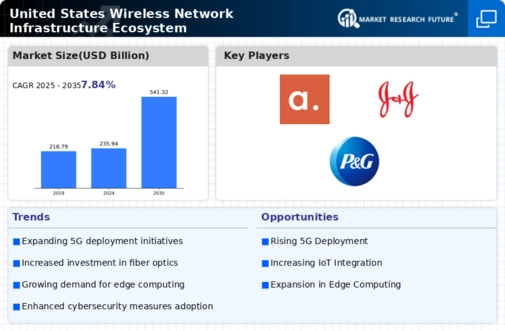The wireless network infrastructure ecosystem market is characterized by a dynamic competitive landscape, driven by rapid technological advancements and increasing demand for high-speed connectivity. Major players such as Cisco Systems (US), Ericsson (SE), and Nokia (FI) are strategically positioned to leverage their extensive portfolios and innovative capabilities. Cisco Systems (US) focuses on enhancing its software-defined networking solutions, while Ericsson (SE) emphasizes its leadership in 5G technology deployment. Nokia (FI) is actively pursuing partnerships to expand its market reach, particularly in the realm of private networks, which appears to be a growing segment. Collectively, these strategies indicate a trend towards specialization and collaboration, shaping a competitive environment that is both robust and multifaceted.
Key business tactics within this market include localizing manufacturing and optimizing supply chains to enhance operational efficiency. The competitive structure is moderately fragmented, with several key players exerting influence over various segments. This fragmentation allows for niche players to emerge, while larger companies consolidate their positions through strategic acquisitions and partnerships. The collective influence of these key players fosters an environment where innovation is paramount, and agility in responding to market demands is crucial.
In November 2025, Cisco Systems (US) announced a significant partnership with a leading cloud service provider to enhance its edge computing capabilities. This strategic move is likely to bolster Cisco's position in the market by enabling more efficient data processing at the network edge, thereby improving service delivery and customer satisfaction. Such partnerships are indicative of a broader trend towards integrated solutions that combine hardware and software to meet evolving customer needs.
In October 2025, Ericsson (SE) unveiled its latest 5G radio system, which is designed to optimize energy efficiency and reduce operational costs for network operators. This innovation not only reinforces Ericsson's commitment to sustainability but also positions the company as a leader in the transition towards greener technologies in telecommunications. The emphasis on energy-efficient solutions is becoming increasingly relevant as operators seek to balance performance with environmental responsibility.
In September 2025, Nokia (FI) secured a major contract with a prominent telecommunications provider to deploy its private wireless network solutions across multiple industrial sites. This contract underscores Nokia's strategic focus on the industrial sector, where demand for secure and reliable connectivity is surging. By capitalizing on this trend, Nokia is likely to enhance its competitive edge and drive growth in a sector that is becoming increasingly critical to the overall economy.
As of December 2025, current competitive trends are heavily influenced by digitalization, sustainability, and the integration of artificial intelligence (AI) into network operations. Strategic alliances are playing a pivotal role in shaping the landscape, as companies collaborate to develop innovative solutions that address complex challenges. Looking ahead, competitive differentiation is expected to evolve, with a pronounced shift from price-based competition to a focus on innovation, technology, and supply chain reliability. This transition suggests that companies that prioritize these elements will be better positioned to thrive in an increasingly competitive market.














Leave a Comment